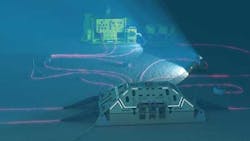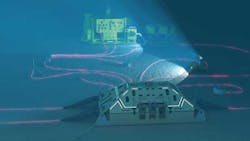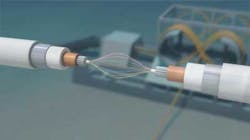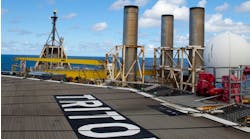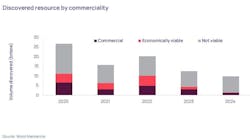David Pfosi
Joe Friedman
Harris CapRock Communications
Providing high-throughput, highly reliable communications to harsh, remote locations has many inherent challenges, including significant up-front costs, technical risks, and elevated repair and maintenance costs. While oil and gas professionals are familiar with the difficulties of recovering hydrocarbons from deepwater locations, they are not always as familiar with the challenges of communicating from these offshore sites back to land.
The value of improved offshore communications lies in remote asset monitoring and subsea sensing; video and telephonic conferencing; the ability to stream videos of operations from the oil rig or ocean floor; improved quality of life for offshore personnel; and increased employee retention. The ability to perform these capabilities, even when in remote locations, demands higher than ever throughput.
In addition to basic voice and data access, companies rely on bandwidth to support real-time applications that improve productivity, security, crew welfare, and more. This requires a reliable and robust network communications structure to equip exploration vessels, workboats, tankers, production platforms, and remote drilling sites with full corporate network assets.
For more than 50 years, very small aperture terminal (VSAT) satellite technology has been the standard for offshore communication, but today's requirements may rapidly exceed the capability of even high-throughput satellite communications.
Today's multi-tenant environments require application-centric networks. However, the challenges of designing, installing, operating, and maintaining these complex communications systems can distract from core operations. Managing these comprehensive communications architectures requires a committed focus, experience, and proficiency in advanced communication technology.
In the past, offshore communication systems needed only basic bi-directional communication of relatively minimal data. As the industry's operational technologies become increasingly complex and automated, new systems require exponentially greater throughput to accommodate this increased bandwidth need. Today, data transmission requirements are increasing year over year, and throughput needs will grow more than 20% in the foreseeable future.
A case for fiber
Offshore operators frequently manage multiple oilfield assets independently, and then consolidate the most critical information received from each for review. When data throughput is limited, information must be prioritized quickly by perceived order of importance; often, some information does not "make the cut." This can affect the safety, security, efficiency, and overall success of deepwater offshore operations. Achieving the required levels of data transfer without compromising mission-critical communications requires more than satellite alone, and traditional land-based communication methods are non-starters in deepwater operations due to architecture, material, and price limitations. Major information resources like network enterprise application systems traditionally involve disjointed processes. If oil companies integrate operations, they can deliver up to a 7% increase in recovery and material cost efficiencies. This opens the door for innovations in offshore oil and gas communications, like the use of subsea fiber-optic networks.
Subsea fiber-optic networks on deepwater offshore assets provide high-speed connectivity and a host of cost-effective communication options to multiple customers simultaneously. A strategically deployed fiber-optic backbone connects the mainland infrastructure to the subject fields, with branches deployed from the core backbone to additional sites.
To further maximize the reach and capability of the fiber backbone, surrounding platforms and assets can be linked directly with a physical fiber connection or remotely "hopped" onto the fiber backbone using line-of-sight radio frequency (RF) links. An omnidirectional RF cloud can be added to blanket an entire area, turning offshore assets into at-sea communications hotspots. This fiber and RF hybrid network of communication tools creates a meshed grid of assets with multiple high-bandwidth options and increased reliability. Whether fixed or floating, stable or mobile, all assets connected through the communications mesh achieve high-speed, high-reliability connectivity that allows vast amounts of data to be transmitted safely, securely, and simultaneously.
Network architectures are scalable and forward-compatible, so as a field expands, additional assets can connect. Once configured, data is routed via the new fiber or RF connection, while the original legacy satellite communication system can remain intact as a backup.
When a company's collection of offshore assets, platforms, seafloor equipment, and vessels all are connected through a high-speed network, vast amounts of information can be shared instantly without the latency constraints. An onshore master facility - typically an existing corporate office - may then serve as the central hub of communication by collecting and coordinating critical data while disseminating information and directives to offshore assets.
Further use of available bandwidth allows mobile assets like supply and support ships to connect directly to the system when near enough to the communications mesh. The advantages of leveraging optical backbone network architecture and related communication assets are many, and can have price advantages over existing methods.
Lease lengths are negotiable and tend to correspond to the estimated life of the field site. Once the high-speed architecture is operational, bandwidth allocations allow simultaneous sensor data transfer, video and telephonic conference calls, photographic exchanges for remote troubleshooting, wireless access with exceptional speeds for crewmembers, and many other activities. This advanced bandwidth allows "full take" data sorting and storage onshore, and promotes efficiency in problem resolution. Eliminating latency, for example, affords high-definition video conferencing between multiple sites for "face-to-face" problem solving. Additionally, crews accustomed to instant connectivity onshore gain access to video conferencing programs and other telephonic options to contact family and friends without compromising or interrupting critical data transmissions.
Sharing networks safely
While the benefits of high-speed networks offshore are recognized by most organizations, the upfront costs and learning curve often prevent companies from creating proprietary networks. Even companies familiar with the technology typically outsource communications to focus on other priorities. As a network integrator and communications provider, Harris CapRock leases high-throughput, high-reliability communications as a secure, managed service to multiple users in a given geographic area, similar to a terrestrial telecommunications provider that offers telephone and Internet service to a local group of users. The company has supported and maintained the Central North Sea Fibre Telecommunication Co. (CNSFTC), which serves 20-plus platforms and multiple companies in the North Sea. Installed in late the 1990s, CNSFTC comprises a system of subsea cables with up to 48 fibers per cable, and topside RF links connecting assets up to 45 km (28 mi) apart.
It also connects Aberdeen, Norway, and London as a potential component in national and international telecommunications networks. The system is monitored at one of five support centers for trending and around-the-clock troubleshooting.
Information security on a shared network is paramount. Harris CapRock uses a combination of hardware and software solutions similar to those employed for secure intercontinental banking to provide security. Software solutions include data encryption and the use of virtual private networks (VPN) and/or virtual local area networks (V-LAN).
Individual users on a shared network may also be provided transceivers tuned exclusively to different frequencies, ensuring data separation during simultaneous, parallel transmission. For example, one user's transceivers may send and receive data through the network using only 1,550 nm wavelengths, while another user communicates exclusively at 1,570 nm. Neither user's equipment can "see" or decode the others' transmissions.
Integrating an optical network provides options to meet and exceed expected future regulatory requirements, and includes additional bonuses, such as telemedicine solutions. This high-bandwidth service can provide real-time, high-definition video-conferencing from onshore doctors and specialist to offshore operations for immediate medical attention, and can reduce the need to transport employees and physicians.
